

Thirty years in heaven
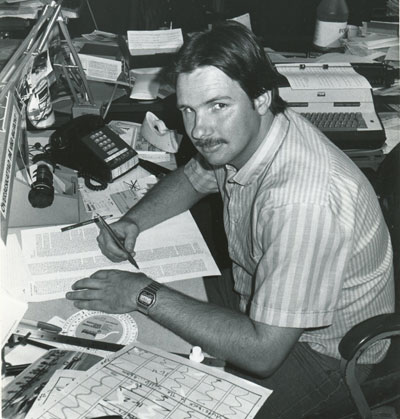 (Above) Me, in 1985. Sharp-eyed readers will note the typewriter (electric at the time, but I started on a manual), the photo-sizing wheel (Photoshop? Ha!) and the pica-pole ruler by my left hand, and pen-and-paper method of designing pages. Those were the days! (Below) Me now. Moustache gone, hair thinner, waist thicker, but passion still intact deep inside. |
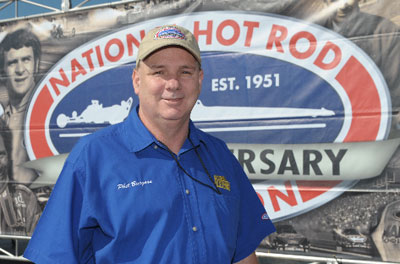 |
Yesterday, May 24, 2012, marked my 30th anniversary under the employ of the big red and blue oval that has been my life for well more than half of my life. I joined the NHRA family and the National DRAGSTER staff two days after my 22nd birthday, happily taking a $7,000-a-year cut in pay to begin my dream job (don’t tell Wally Parks, but I probably would have paid him for the chance to work here).
After a roundtable grilling by the staff on my knowledge of the sport -- it was the job interview I'd unknowingly been studying for since I was 10 years old, devouring every drag racing magazine I could get my hands on -- and passing a nerve-racking one-on-one with Wally, I was invited to join the team, and I did so stoked by a burning passion to tell our sport’s story to as many people as would listen.
There certainly was nothing wrong with National DRAGSTER at the time – and I had been a loyal member/reader for years before I joined the team – but we all knew that there was a lot more we could do. The mid-1980s was a period of unprecedented growth for ND, not just in terms of readers, but also in the scope of the stories that we were given the permission – and column inches – to tell.
I’ll be honest: Wally fought us along the way. He was a pure nuts and bolts guy, and some of the crazy stuff we did – trivia contests, top 10 lists, humorous photos and captions – sometimes was not appreciated by him but drew praise from readers to the extent that he knew we were on to something and let us have our way – not that a scathing “Wally memo” was ever far from our minds.
Still, in the end, I earned Wally's trust and support in ways I never could have imagined. For the first 20 years of my editorship, he could be critical of the direction I was trying to take the paper, fretting about wasted space on this or missed opportunities on that, but the last five years, he was our biggest cheerleader and so proud of what National DRAGSTER had become. In 2000, seven years before he passed, I pleaded for and received an extensive sit-down interview with him, where I got to ask all the questions I had so that after he was gone, I could continue to share his side of NHRA’s early story, which was instrumental in our 50th Anniversary celebration in 2001.
Headquartered on Riverside Drive in North Hollywood, the NHRA staff of those early 1980s was small – probably no more than 25 – but filled with characters I’ll never forget, including ND’s photographic Frick and Frack, Leslie Lovett and the wacky Bill Crites; the grandfatherly genius Bill “Farmer” Dismuke; wheeler-dealers like Brian Tracy and John Mazzarella, who could sell you the shirt off your own back, each with a distinctly different style; and the leaders I looked up to for guidance and acceptance, like Parks, Dallas Gardner, Carl Olson, Steve Gibbs, and Bernie Partridge. As you may have heard, things were a lot looser and informal then, but, boy, we got things done. I’m proud to have been counted among that group that helped cement NHRA’s reputation in the 1980s and beyond and dearly miss those who have left us, especially Leslie.
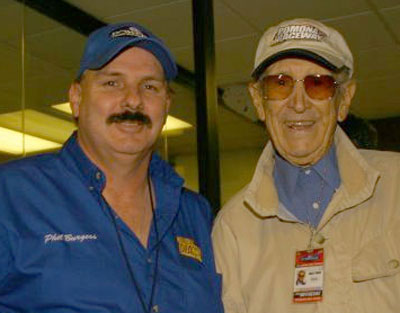 (Above) Me and Wally. It was my honor to know and work with him. (Below) Me and Leslie, on the starting line in Pomona. I miss them both dearly. |
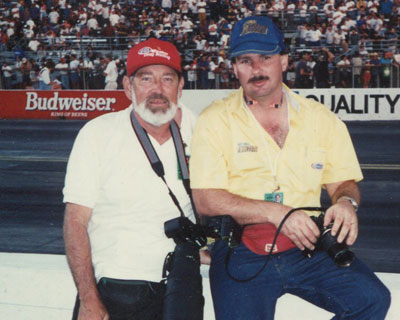 |
In my first years, Leslie took me under his wing and taught me about life on the road, and it was a far different experience then. Many was the time we’d finish the edition late Wednesday, catch a red-eye that night to the event, head straight from the airport to the track, and work all the next day before we finally were able to catch some sleep. Sunday night was the reverse; we’d zip through winner’s circle photos, jump in the rental car, and haul ass for the airport, hoping to catch the last flight home so that the hundreds of rolls of film – remember film? – could be dropped off at the processor (usually around midnight) and ready for pickup bright and early the next morning.
Leslie taught me about photography and about how to interact with the racers. I’ve never seen anyone as universally loved by the racers as was Leslie. I learned from him the value of having the trust of the racers, and it’s been a strict rule here ever since, keeping “off the record” just that, verifying information before committing it to print, and zealously guarding and maintaining the trust.
As the editor since 1986, I’ve been blessed to lead some of the finest reporters, copy editors, and photographers in the sport, and their passion for the sport – for getting the facts straight and the images to be compelling – shows in every issue. I’ve been here for more than 1,400 of them, and they’ve all gone out the door without fail each week, a tribute not only to being able to meet tough deadlines with quality work, but also to the Advertising and Production staffs – the unsung heroes whose credits appear only in the Table of Contents each week – who keep the machine running, and to my many bosses along the way, who in showing faith in me instilled confidence, loyalty, and the unflinching desire to always work harder and longer for them. Thanks, everyone.
Having a job like this, where you get to travel the country and have biweekly family reunions with the traveling band of gypsy Pro racers, was more than a hard-core fan like me could ever imagine. I’ve said it before that there were times I clung to the ropes of Don Prudhomme’s pit area, eager for just a nod or a “Hey, kid,” and now “the Snake” calls me at home just to chitchat. The list of legends in the sport whom I now can proudly call good friends – and, in some cases, confidants and advice seekers – is truly humbling and runs the gamut from Shirley Muldowney to Tom McEwen to John Force. Tuesday was my birthday, and not only did “Snake” call, but it was Bob Brandt who reminded him it was my birthday. You can't imagine what that means to the kid who grew up idolizing both of them and following their heroics. Roland Leong – who shares my birthday and somewhere along the line also took a liking to me – emailed me, and my Facebook and Twitter feeds went berserk, too.
 The job has been almost too much fun to even call a job sometimes and afforded me opportunities to see and do things and go places I never would have dreamed, many of which I’ve written about here.
The job has been almost too much fun to even call a job sometimes and afforded me opportunities to see and do things and go places I never would have dreamed, many of which I’ve written about here.
I got to attend the last few years of NHRA’s only national event outside the U.S. borders, Le Grandnational in French-speaking Quebec, which was like visiting a foreign country. And, believe me, the last thing you want to do is visit a foreign country with Crites as your guide. I think I’m still on Interpol’s most-wanted list.
I got to visit New York, something this California kid never imagined. Every trip to Englishtown included an excursion into the Big Apple, where we dined in Little Italy and Chinatown and scoured the record stores of Greenwich Village for Bruce Springsteen bootlegs. And, of course, I met my rock 'n' roll hero Bruce at Raceway Park but was too cool (read: stupid) to even ask for an autograph or a photo op.
The Big Apple was cool from a touristy standpoint – and, honestly, we seldom get the chance to sightsee while we’re at the races anymore – but from a drag racing fan standpoint, there’s no forgetting that first trip to Indy, which for me came in 1983, and I haven’t missed one since. Just to be able to walk onto those hallowed grounds and see the Valhalla that I’d only seen in photos (the original Hurst Bridge and original four-story timing tower were still in place that first year) gave me goose bumps that I still get every time we pull into the gates.
I’ve been places and seen things a guy can only dream about – like the Playboy Mansion for Prudhomme’s retirement party in 1994 – and been on fun trips like my journey to Lake Placid a few years ago for the NHRA vs. NASCAR bobsled competition. After an overnight stay at their amazing home, I flew with Jeg and Samantha Coughlin in their private jet right into the local airport and enjoyed two days of fun, including a few rides down the historic Olympic sled course. During Jerry Toliver’s years with the WWF as his sponsor, I got to be the coolest dad on earth by getting my son, Chris, backstage at one of their big shows to meet his hero, “Stone Cold” Steve Austin. I shot trap (and didn’t embarrass myself or accidentally shoot anyone) with Robert Hight.
Naturally, I’ve seen amazing moments on the racetrack, from incredible performances like Don Garlits’ shocking 1984 Indy win, Austin’s near double at the 1991 U.S. Nationals, and Tony Schumacher’s “The Run” at the 2006 Finals. I witnessed both ends of Shirley’s tragic 1980s; I was in Montreal when she crashed and in Phoenix in 1989 when she made her return, and I saw Darrell Gwynn’s triumphant last win in Gainesville in 1990 and flew to Miami for his first public appearance after his career-ending accident; I was touched and amazed by the grace and strength of them both.
I flew once to Noble, Okla., to see fire-wary Force test perhaps the most gadget-laden Funny Car in existence, equipped with pneumatic cylinders to unlatch and toss off a burning body (linked by cable to the chassis), an extra parachute under the body, and aluminum casters on the chassis in case he lost the rear tires. I’m surprised it didn’t have an ejection seat. In the summer of 1984, I flew to Kansas to spend the weekend with the Patterson family and Kip Martin, then drove to Bartlesville, Okla., to do a feature on the rare Mustang Super Stocker of Lloyd Bray and D.G. Gillam, two of the many great people I met along the way. We lost Lloyd earlier this year, and even more than 25 years later, D.G. kindly thought to call me to break the sad news.

The DRAGSTER staff celebrated with Wally in the Indy winner's circle after producing the Daily DRAGSTER at the 1988 U.S. Nationals. That's me, third from right, in the back row.
|
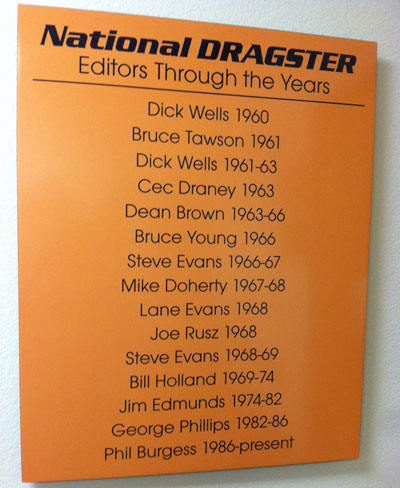 I keep this little sign -- from ND's 50th Anniversary display at the NHRA Museum -- on the wall in my office to remind me of all of those before me who have helped make National DRAGSTER what it is today. |
Although my heart and soul for the last 30 years has been the weekly thrill of National DRAGSTER – I’ll always bleed blue and yellow – I’m proud of the other work we’ve done in the Publications group. In 1988, the National DRAGSTER staff went daily with a groundbreaking publication at that year’s U.S. Nationals, Daily DRAGSTER, published each night and delivered free to the racetrack and area hotels. It was a logistical nightmare – remember, this was before digital photography – yet the hard work, diligence, and planning that went into each year meant we never missed an issue. It was unprecedented work and gave hard-core fans at the race in-depth daily coverage they never imagined possible in those pre-Internet days.
In 1995, I obtained permission to explore this wacky little craze just beginning to gain steam – a little something called the World Wide Web – and helped build what is now NHRA.com, and for the past 17 years, I’ve helped feed its voracious appetite for content. Like the Daily, it has evolved with the times – including the addition of the world-famous audiocast in 1998 – and, again, it’s been a tremendous team effort. There is not a dedicated staff for the website, but so many from the Editorial, Photography, and IT departments double up on their jobs to ensure that it runs smoothly. Early on, we partnered with the group now known as Summit FastNews to provide our results, and the work they’ve done throughout the years (beginning in 1997) has given fans around the globe better access to the sport.
Then, of course, there’s this little column you’re reading, a twice-weekly endeavor that, through your kind and generous contributions and enthusiasm, has far exceeded what I ever imagined it could be. The praise that is heaped upon me each week is truly humbling, and yet the honor and privilege of doing it is all mine. The thrill of uncovering some lost facet of our history and continuing to honor those who have created the history is matched only by the joy of being able to share it with such an appreciative audience.
Again, thank you.
Yesterday, as I walked to the doors of HQ, I actually stopped and stared up at the NHRA logo on the front of the building, the same way I did so many years ago in front of the HQ building on Riverside Drive in North Hollywood. Back then, I’m sure I took a deep breath and nervously stepped through the front door, uncertain of what may lie ahead but excited at the prospects.
Yesterday, I walked through the front door, thankful that even my wildest fantasies from that day were no match for the reality that became my life with NHRA.



















































